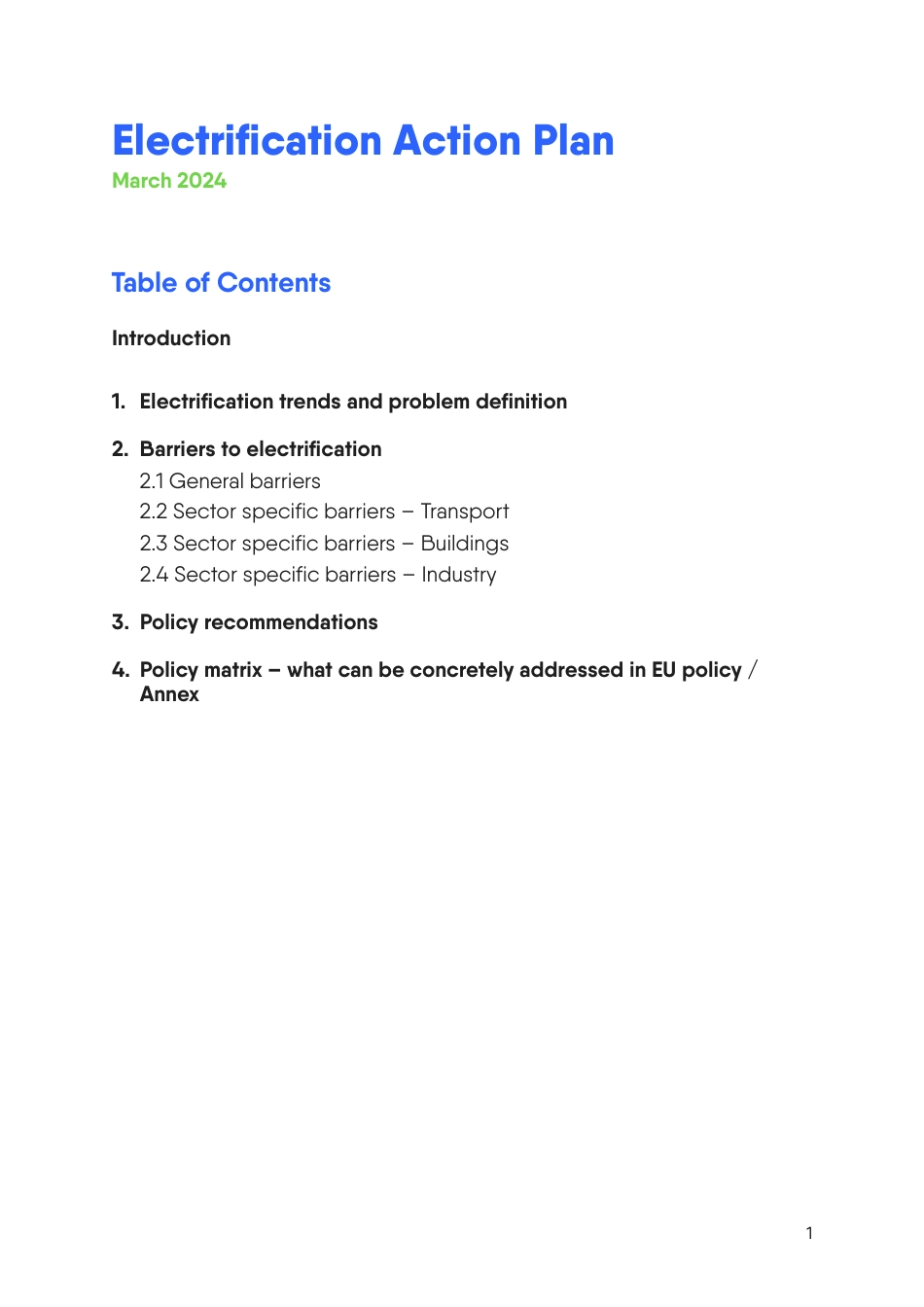ElectrificationActionPlan1ElectrificationActionPlanMarch2024Introduction1.Electrificationtrendsandproblemdefinition2.Barrierstoelectrification2.1Generalbarriers2.2Sectorspecificbarriers–Transport2.3Sectorspecificbarriers–Buildings2.4Sectorspecificbarriers–Industry3.Policyrecommendations4.Policymatrix–whatcanbeconcretelyaddressedinEUpolicy/AnnexTableofContents2Introduction:Decarbonisationthroughelectrification-whyweneedanEUElectrificationActionPlannow.Electricitymakesuponly23%ofalltheenergyconsumedinEurope.Thismeansthatwhileweareworkinghardtodecarboniseelectricity,largepartsoftheeconomyarestillrunningonfossilfuels.Ifwearetohaveanyhopeofachievingourclimateandenergypolicy,weneedtorampupelectrificationasquicklyaspossible.Thiselectrificationchoiceisalsoanoregretoptionforenergyefficiency.Deployingheatpumps,forinstance,couldreduceenergydemandbytwo-thirds.Allmodellingshowstherateofelectrificationwillneedtoreacharound50%upto70%by2050forEuropetoreachclimateneutrality,accordingtoourDecarbonisationSpeedwaysstudy.Inthemediumterm,toachieveourREpowerEUambitions,weneedtoalreadyreach35%by2030.Europemustsetboththerightmilestonesandaclearplantodeliverthattrajectory.Therefore,weaskpolicymakersto:•ReinforcegovernancewithanEUElectrificationActionPlan-PublishanElectrificationActionPlan(EAP)thefirst100daysofthecomingmandatewiththebuildingblocksoutlinedinthisfiletoguidepolicymakers.Thisshouldsetanindicativetargetof35%electrificationoffinalenergyuseacrosstheEUby2030.Inaddition,anelectrificationindicatorinthenationalenergyandclimateplans(NECPs)tomonitoranddeliverprogressshouldbeintroduced.•Showcasethetruevalueofelectricity-Continueeffortstorelievetheelectricitypriceoftaxesandleviestocreatefavourableeconomicconditionsforconsumerstoswitchfrommorecarbon-intensiveenergycarriers.•Increaseawarenessofelectricity’scostsavingpotential-Acknowledgethatourexposuretovolatilefossilfuelimportsfromexternalsourcesiscomingwithamassiveyetavoidablecost:thepositiveimpactoflarge-scaleelectrificationwithcleandomesticpowergenerationonsecurityofsupplyshouldbedulyconsideredasasavinginthemidtolongterm,ratherthanjustanexpenditure.ThisEAPservesthereforeasaguidancefordedicatedpolicyproposalstoletelectrificationplayitsrequiredroleintheenergytransitionandguideEUMemberStatesinsuccessfullyimplementingprovisionsfromtheEuropeanGreenDealandtheREpowerEUlegislationwithdecarbonisationandelectrificationatitscore.TheEAPisalsonotanendinitself:furtheranalysisisneededtobetterunderstandtheeffectsofanincreasedshareofelectricityincertainsectorsoftheeconomywithduerecognitionofsectorspecificdifferencesandstartingpointsindecarbonisationofthevariousEUMemberStates.31.ElectrificationtrendsintheEUandproblemdefinitionElectrificationtrends:ataglanceOverall:IntheEU,electrificationstagnatedaround23%duringthepastdecadewhichshouldincreaseupto35%by2030,accordingtotheEU’sREpowerEUscenariosandsubstantiatedbytheEurelectricDecarbonisationSpeedwaysstudy.Mostoftheprospectivestudiesforachievingcarbonneutralityshowanincreaseintherateofelectrificationbetween50%and60%andupto70%insomecasesinEurope.Intheupdated2023NetZeroRoadmapreportbytheIEA,atargetofmorethan50%isexpectedin2050worldwide.Atsectorallevel:thealmostflattrendforelectrificationrateiscommontoallend-usesectorsintheEU,seealsosubsequentgraphs.Atnationallevel:electrificationrateshavesimilarevoluti...



 VIP
VIP VIP
VIP VIP
VIP VIP
VIP VIP
VIP VIP
VIP VIP
VIP VIP
VIP VIP
VIP VIP
VIP